A (dentist-approved) homemade toothpaste recipe
Yesterday I finally had a long-overdue visit to the dentist. I haven’t been to the dentist in two years. Whilst you may not think that two years is a terribly long time to avoid the dentist, I must admit that the last time I went the dentist told me that I needed a filling*, and I never bothered to get one.
*To be fair, the dentist seemed quite vague (I think he was a recent graduate), definitely told me it was to be on the safe side, and from what I could see from the x-rays (knowing absolutely nothing about dentistry of course) there was no urgency. So I saved the £120 or so it was going to cost me and cancelled the follow-up appointment.
Moving continents didn’t help either, and then I was further delayed because I rang a few dentists to find out filling prices and all the dentists were really mean. Really really mean. One was outraged that I hadn’t had a filling and told me I would probably need root-canal surgery by now, and another told me that I’d have to have a scale and polish before the dentist would even see me, as their dentists wouldn’t dream of looking into dirty mouths. (For readers who live in Perth, yep, that dentist was in Claremont).
I finally had a recommendation from someone for a dentist whose receptionist was actually nice over the phone, and so I braced myself for the inevitable expense and booked. I also thought that this would be a good opportunity to get some professional advice about my homemade toothpaste… and find out if it was actually working.
Turns out that the dentist I visited is the Nicest Dentist Ever. She didn’t seem phased that I had been told I probably needed a filling and hadn’t bothered to get one. I told her that I made my own toothpaste and we discussed all the nasties in conventional products as well as the fact that I don’t buy products in plastic. I told her what I used to make the toothpaste (recipe below) and she said it contained all the key elements that commercial toothpastes had and would be absolutely fine to use. She was so nice I even admitted that I don’t floss very often.
So she looked at all my teeth, and took some x-rays. She said the brushing and toothpaste was working fine, all the fronts and tops of my teeth were in great condition. I have the green light to continue with my homemade toothpaste!
Unfortunately I still need the filling.
In fact, I need three.
All of the decay is where the teeth touch each other at the sides. Turns out flossing is probably a useful thing to be doing after all.
So, said the dentist. What would I like to do? Obviously I’ll be wanting to keep things plastic-free. She assumed I wouldn’t like the amalgam (silver coloured fillings) because they contain mercury. She also doubted I would like the composite (white) fillings because they are made from resin – or plastic. When I said I didn’t know much about them, she said if I looked them up she was pretty sure I wouldn’t want them either.
I didn’t actually know there were other options. Apparently there is also porcelain, which uses a small amount of resin to bind it but far less than the composite filling, or gold.
Now I’m no gangsta and I’m not sure gold fillings are quite the look I’m after. Porcelain sounds great… except they’re $800 each. Composite fillings are just over $200.
In the end, I chose the composite ones. Plastic or not, I just don’t think I can justify the extra expense.
Appointment is next Tuesday.
In the meantime, it’s great to know that my homemade toothpaste now has dentist approval!
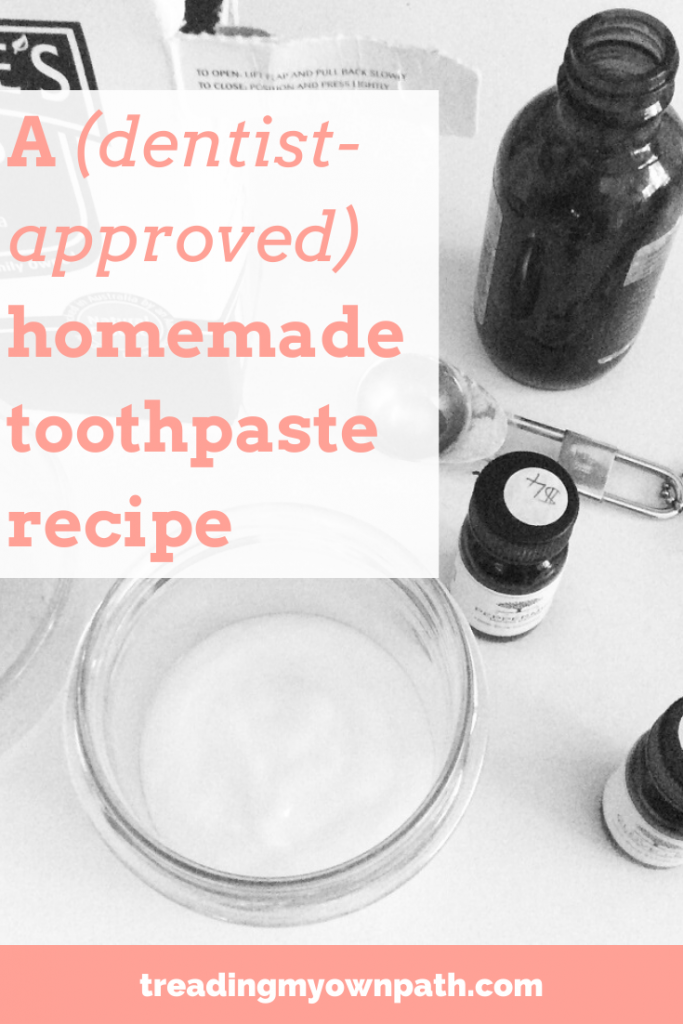
Homemade Toothpaste Recipe – dentist approved!
I’ve posted my original toothpaste recipe here (and also the reasons I make my own in the first place) but this is the one I’ve been using more recently that I’ve tweaked slightly.
Sodium bicarbonate. This is the abrasive that cleans the teeth. It has quite a salty taste that can take a bit of getting used to. It also neutralises stains and odours.
Glycerin. This acts as the lubricant and binder. In the past I’ve also tried coconut oil. I’ve read that glycerin can coat the teeth and form a barrier that prevents re-mineralisation, and some natural toothpaste users prefer coconut oil. However, because sodium bicarbonate can be quite abrasive the glycerin can help protect the teeth. The dentist thought glycerin was better suited than coconut oil.
Peppermint oil. I add this to give the toothpaste the fresh minty taste that psychologically we associate with toothpaste.
Clove oil. I started adding this recently because clove oil has great anti-microbial, anti-viral and anti-fungal properties. You often see clove oil in natural toothpastes and the dentist told me that she still uses it for some of her procedures.
And that’s it! I no longer add extra salt as I found the taste too salty, and the dentist said that with the bicarb it’s not neccessary to have another abrasive.
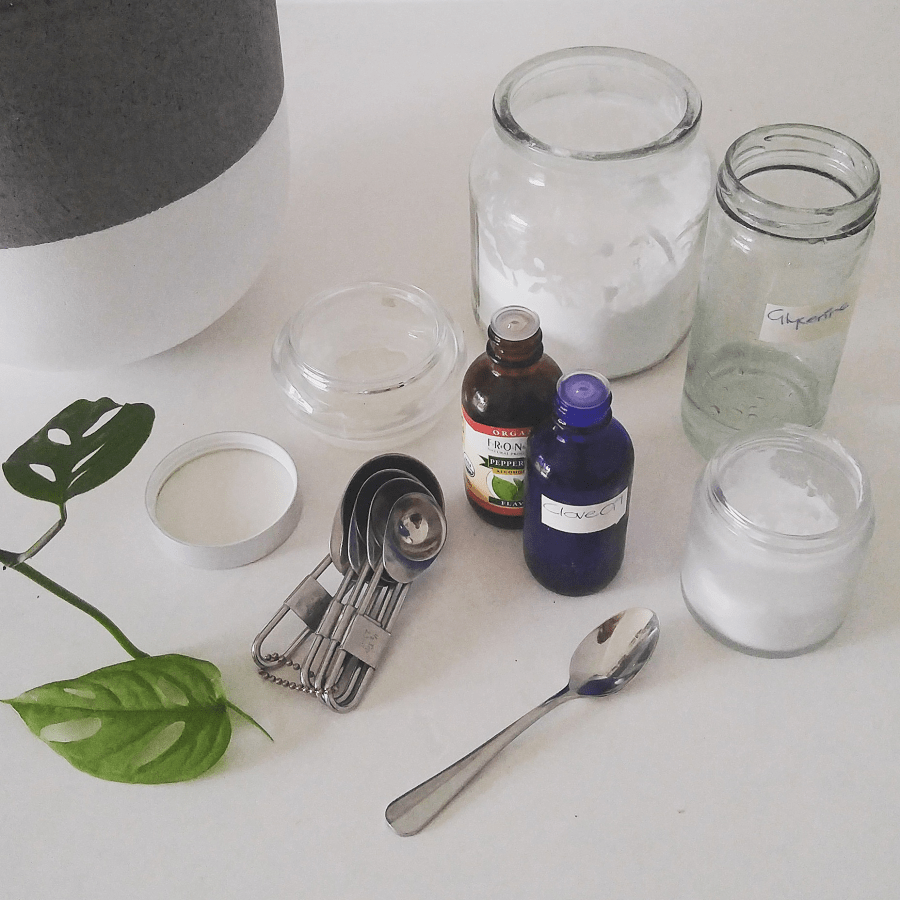
Method:
Mix 8 tbsp sodium bicarbonate with 6 tbsp glycerin. Add 10 – 15 drops of peppermint oil and 1 drop of clove oil. That’s it!
Store in a jar.
A couple of final things. The dentist also said that what can be more important that the abrasive in the toothpaste you use is the type of brush. Often toothbrushes are more abrasive than the toothpaste. She recommended using a soft toothbrush, particularly if you are worried that your toothpaste is too harsh.
The last thing to bear in mind is that not everything works for everybody all of the time. There are people who only drink fizzy drinks and eat daily Mars bars and have great teeth, and there are others who only eat salad and have mouths full of cavities. This toothpaste contains all you need in a toothpaste to keep teeth and gums healthy, and it is working for me. It should work for you too, but be mindful of what’s going on in your mouth, and if you suspect things are awry, maybe consult your dentist?!
[leadpages_leadbox leadbox_id=1429a0746639c5] [/leadpages_leadbox]
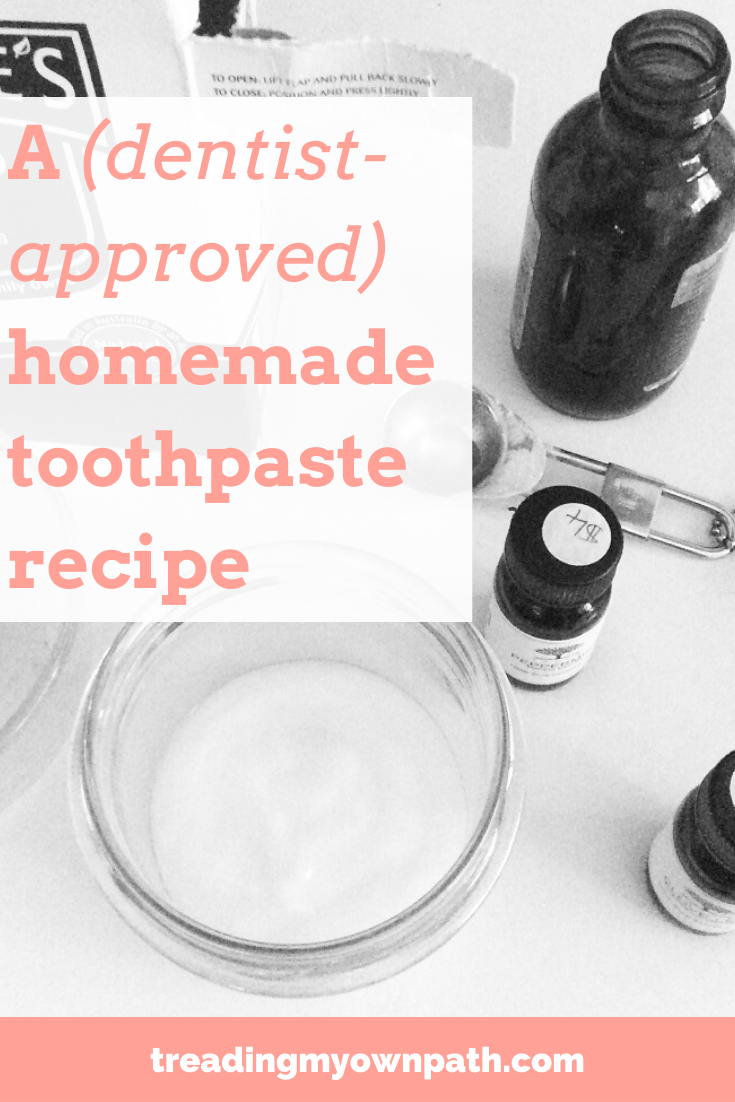

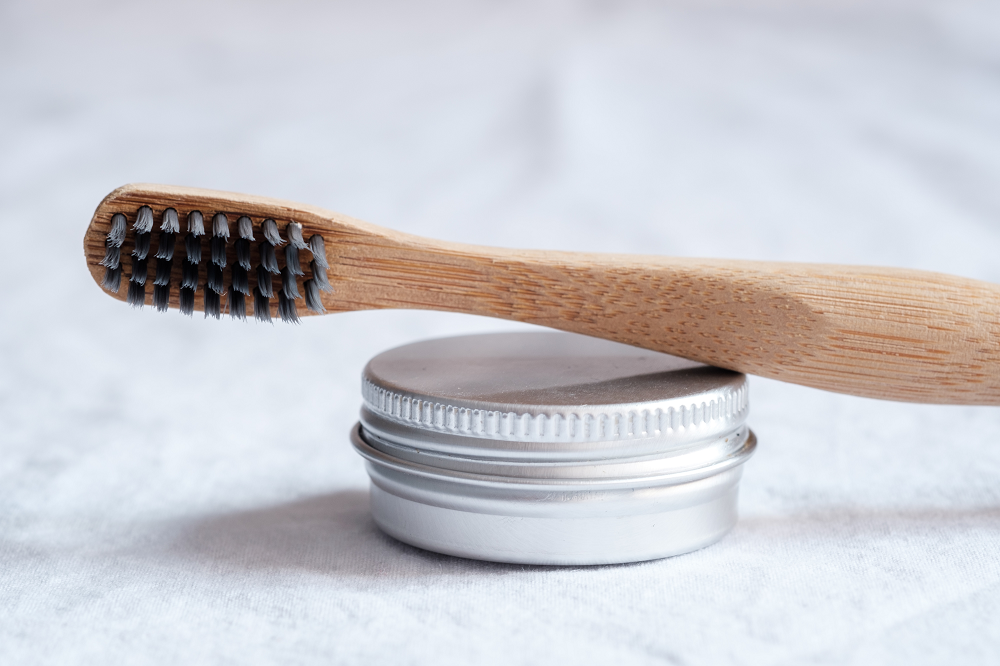

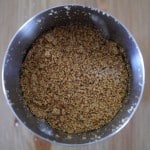

Thanks for sharing the contents and procedure to make toothpaste at home. Tooth filling is important when there is decay in our tooth. It depend on our budget, which filling should we use for dental filling.
OOoo that’s good to know! I can’t wait to see what the dentists think of my teeth after our homemade toothpaste either. Mainly my silly wisdom teeth , which are getting to ‘need to be extracted’, but every time they become inflamed I mouthwash with gin (works fairly well and IMO better than commercial stuff), used vodka before but i prefere gins flavour (but not the burn, oh gosh not the burning!).
good luck with the dental work! :)
That commercial stuff is full of alcohol anyway, isn’t it? And a load of other rubbish. Mouthwashing with gin is pretty hardcore though!
I know this is an old thread but for the sake of people still reading this blog. Please don’t use alcohol as mouthwash it is proven to cause mouth cancer!
Just come across this blog and thought you might appreciate this, though it’s quite a while since your comment, but maybe someone else will find it useful…
I have the same problem with inflammation around my wisdom teeth from nuts and seeds getting caught in gum pockets. I had a couple of really bad occasions earlier this year that required antibiotics, and thought I was going to need a third prescription until I tried using oil drops in my water flosser every night (I was using it without the drops previously).
I make a small dropper bottle (every 3 months or so) of 30ml Sweet Almond Oil, 5 drops Rosemary Oil, 7 drops Peppermint Oil, and 5 drops Tea Tree Oil – all anti-inflammatory and anti-bacterial oils.
I add 4 drops of this mixture to the water flosser reservoir with filtered water every night and make sure it gets right into the gum pockets. I’ve not had a flare up in months. A couple of times I’ve missed a night and felt a bit of inflammation, but as soon as I use the drops again, it goes away. You can add a drop or two to your toothbrush as well/instead.
I was wondering about toothpaste, partly for the plastic issues, but also because of the nasty ingredients in the commercial ones. I’ll try your recipe, and thanks. (As to fillings, Dental Insurance from my long-time job was a great benefit)
I’ve been using homemade toothpaste since February this year and it works fine, although the taste took a while to get used to! But that’s the same for lots of things. Good luck!
Hi, I love your blog. You’ve inspired me to start doing some stuff that I’ve been meaning to start, like yoghurt making and nut milks as well as giving away things. Could you please tell me where you source the peppermint and clove oils? Thanks!
Thanks so much! You can buy the oils in most health food stores. I buy mine from a local producer who sells at local markets, but they are pretty easy to find – at least in Perth! Otherwise you could try online?
Cheers.
Wonderful share, great article, I liked the how to brush teeth link the most. I really feel that brushing properly is important.
You mention soft toothbrushes–I have yet to try the bamboo brushes. Would you call them abrasive?
Hi Lindsay,
In order to get ready for Plastic Free July, I would like to try your toothpaste recipe, but I have two questions:
1. Can clove oil be replaced by teatree oil? it seems that they have the same properties more or less. It is just that I already have the teatree oil, while I would need to buy the clove one.
2. if Glycerin prevents the mineralization of the teeth, while coconut oil might not protect the teeth from the abrasion of baking soda… which one would you advice is better in the overall?
Thank you!!
Hi Ady, thanks so much for your comment and so sorry I missed it at the time! I realise this is a little late for Plastic Free July (!) but thought I should still answer.
I wouldn’t use tea tree oil, it’s poisonous. Clove oil is used by dentists even today, so it’s a well known remedy. On the plus side, clove oil is great for killing mould so very useful in the bathroom.
I prefer glycerine, it’s what toothpaste used to be made of and gives a more traditional toothpaste taste and texture. Coconut oil just melts immediately. I prefer glycerine, and if you are just starting out I’d recommend that – it makes the transition easier.
This sounds like something I could do. Just wondered if it forms a paste or not? What size jar do you need? And, how do you dig it out of the jar onto your toothbrush each time? Thanks! Brilliant!
Hi Debbie! If you use glycerine it forms a (slightly sloppy) paste. I just use a small jar, maybe 60ml – 100ml. But you could make more, there’s nothing in it to go off. I use the back end of a spoon (the nib of the handle) and then spread on my toothbrush. When it’s near the end I just scoop the rest out with the toothbrush itself. Hope that helps!
HI Lindsay, just wondering if you’ve been able to find some dental floss that inst plastic? I have no idea what to use and I’m an avid flosser. Ive tried cotton string but its too weak and breaks.
Hi Stephanie! There are quite a few brands now that sell dental floss made of silk, that comes in glass bottles – and which also have refills. I think Go Bamboo has one, there’s definitely a German brand, and a friend told me of another recently from the US (that comes in compostable packaging). I’m yet to see any hear in Perth but it definitely exists!
I honestly have to say I love you blog. I am vegan and didn’t realize how much plastic I’ve been using. I am trying tomelimate all plastic in my life and realize that it is a process to finding alternatives even down to the simple things like prescription pill bottles I receive. Thanks to your blog I am switching to making my own toothpaste, buying products in bulk with reusable cloth bags, and much more. Thank you from the bottom of my enviornmental lay friendly heart and soul.
Glycerin is not a good ingredient. Poor choice. Do your research before listening to anyone.
Michael, hello and thanks for your comment. I’d love to know why you think glycerin is not a good ingredient! Poor choice how? I research my choices thoroughly, so I’m intrigued to know what information you have that I don’t! Please share :)
Hi, thanks for sharing your journey. I’m a month in to using my homemade toothpaste and looking to alter the recipe for my next batch. I’m curious as to why you’ve opted for not using calcium powder in yours.
Hey guys, Noosa Basics does a biodegradable natural floss that comes in cardboard packaging :-)
https://www.noosabasics.com/products/dental-floss-with-activated-charcoal
Greetings from Nova Scotia,
Thanks for the recipe! I didn’t have a lot of glycerin on hand so I replaced half with water and it worked great. In addition I replaced clove oil with tea tree oil (because I didn’t have clove oil but it’s on my essential oil list). I also love your deodorant recipe – works amazingly well :o) – and now I a making it for the entire family! Thanks again Lindsay – love your blog btw – very inspiring!
Tea tree oil is poisonous! Don’t poison your kids!
I’m pretty sure it’s only poisonous if it’s undiluted.
Another great post thanks. Just wondering, when you spoke to
Your dentist, did you discuss fluoride? I know over in the UK it is added to all toothpastes but also to our water. I can speak with my dentist here if not.
https://www.nhs.uk/conditions/fluoride/
Thanks
Pippa
you can buy fluoride free natural toothpaste in the UK -eg Kingfisher Fennel toothpaste.Fluoride is NOT added to all water in the UK where did you get that idea from ??
fluoride is not great for your health – it may protect your teeth but it is harmful to the thyroid gland anongst many other things
I really like your blog presentation. It is informative too, at the same time.Thanks for nice information.
I get so much out of your blog! Most sadly, I have now read all you past posts. . I have been using toothpaste made from this recipe and have liked it from day one. I had been buying a special toothpaste without many of the harmful ingredients, to avoid getting my frequent canker sores. But at US$12 a tube, buying it regularly hurt almost as much as the sores. Plus, my mouth didn’t feel fresh after using it. Your toothpaste solves all those issues, and it also just feels good using something I’ve made myself and whose packaging won’t wash up on a beach in the future.
Thanks for all you do! Please keep it up. You’ve got a hoard of loyal readers.
Thanks for the great recipe I made it last night, taste weird but I guess I’ll get used to it! Could you please tell how long can we store it? In the fridge or outside? Many thanks!